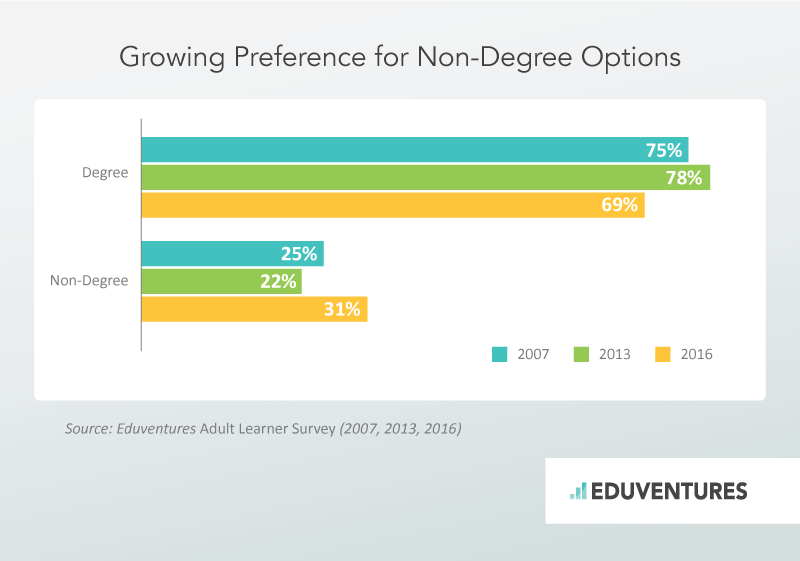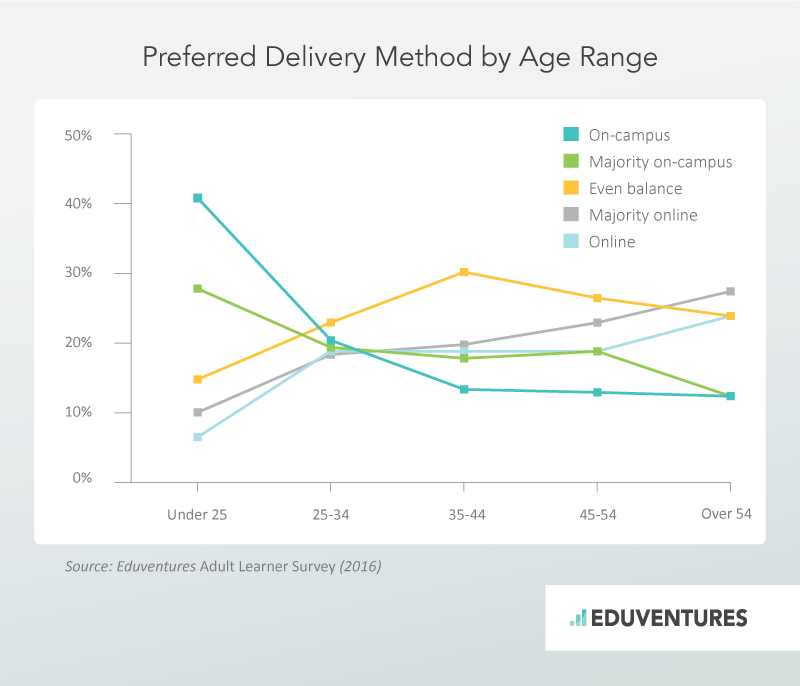Behold your school of continuing education, also known as the extension school, school of professional studies, or center for lifelong learning. It’s perhaps the least understood component of higher education’s confusing taxonomy of how teaching and learning is organized, delivered, and assessed.
It may go by many names, but one thing is certain: the growing population of adult learners is flocking to continuing education (CE) programs. As providers reinvent the model through non-credit and bootcamp-style formats, it is increasingly attracting adult learners who seeking improve their career readiness and prospects for future employment. In turn, colleges and universities are tapping this interest to drive innovation and income more broadly.
According to Eduventures’ recent Adult Learner Survey, nearly half of surveyed prospective adult students characterized a certificate as “just as prestigious” as a degree. Nearly a third (31%) expressed a preference for non-degree options, an increase of nearly 10 percentage points since 2013. While it’s clear that a traditional degree remains the brass ring for these prospective students, this shift illustrates CE programs’ increasing attractiveness.
 Despite this evidence, there’s a persistent mythology shrouding the work of many CE programs. Given its resurgent relevance in higher education, we thought now is a good time to revisit and debunk some of the more common misconceptions about continuing education.
Despite this evidence, there’s a persistent mythology shrouding the work of many CE programs. Given its resurgent relevance in higher education, we thought now is a good time to revisit and debunk some of the more common misconceptions about continuing education.
 Additionally, while CE programs focus primarily on applied learning and are immediately applicable to the job market, traditional degrees are typically driven by research and theory. Rather than detract from the value and brand of their parent institutions, CE programs provide options for students who are unlikely to enroll in traditional programs. In fact, they may actually bolster enrollments in degree-completion and graduate programs. For example, the University of Utah reported that in 2015, nearly 10,000 alumni continued their interaction with the school through Continuing Education and Community Engagement non-credit courses and programs.
Ideally, a CE program serves as the highly attuned front door of an institution seeking to better understand the preferences of prospective adult learners, whether across town or across the country. There’s ample evidence that the new breed of CE programs combine rigor, innovation, and accountability to meet the demands of these learners.
Additionally, while CE programs focus primarily on applied learning and are immediately applicable to the job market, traditional degrees are typically driven by research and theory. Rather than detract from the value and brand of their parent institutions, CE programs provide options for students who are unlikely to enroll in traditional programs. In fact, they may actually bolster enrollments in degree-completion and graduate programs. For example, the University of Utah reported that in 2015, nearly 10,000 alumni continued their interaction with the school through Continuing Education and Community Engagement non-credit courses and programs.
Ideally, a CE program serves as the highly attuned front door of an institution seeking to better understand the preferences of prospective adult learners, whether across town or across the country. There’s ample evidence that the new breed of CE programs combine rigor, innovation, and accountability to meet the demands of these learners.
 Despite this evidence, there’s a persistent mythology shrouding the work of many CE programs. Given its resurgent relevance in higher education, we thought now is a good time to revisit and debunk some of the more common misconceptions about continuing education.
Despite this evidence, there’s a persistent mythology shrouding the work of many CE programs. Given its resurgent relevance in higher education, we thought now is a good time to revisit and debunk some of the more common misconceptions about continuing education.
Myth #1: CE is not academically rigorous.
One of the leading mistruths about CE is that courses and programs are not as rigorous as hallmark degree programs. In reality, exemplary CE units comply with identical approval processes. For example, at one of the largest programs in the country, UCLA Extension, administrators must obtain approval from the academic senate for all professional-level programs, which account for most of Extension’s academic portfolio. Programs are proposed by an advisory committee of seasoned faculty in the field and industry experts. As an academic unit of UCLA, Extension’s offerings are accredited and typically provide additional alignment with professional associations. UCLA Extension’s approval system is one example of how CE courses, programs, and faculty are thoroughly vetted and meet the expectations of a leading university’s degree programming.Myth #2: There’s little to no demand for CE.
It’s easier to solve a Rubix cube than it is to measure retention and completion rates in non-degree CE programs. Sources like IPEDS don’t require schools to report data on their non-degree programs, and the Bureau of Labor Statistics may not always account for non-degree conferrals. Thankfully, other sources can shed light on these gaps. Perhaps reflecting the growing popularity of non-degree programs, the U.S. Census Bureau has begun to track the rates at which adults have earned or renewed a certification, license, or educational certificate. It estimates that in 2012, 25% of the adult population held some level of professional license and more than 90% indicated they had to take courses or training in order to earn the credential. These credential seekers will likely turn to local institutions of higher education to keep up with relicensing requirements. Further, many heavily regulated industries require CE, and employers will undoubtedly value efficient pathways that build workforce-focused skills and knowledge. Data-savvy administrators are well-advised to tap into data sources beyond IPEDS in order to gauge market demand for certificate CE programs.Myth #3: CE schools play by their own rules.
Continuing education programs are sometimes characterized as completely profit-driven and more interested in headcount than the quality of student experiences and results. In reality, at the lion’s share of public and private institutions, CE programs abide by the same guidelines for hiring faculty and staff, working with students, and maintaining academic and financial records. They often hire under the same pay structures and are as committed to quality and excellence as other academic units. CE programs may have the freedom to set their own fee structures and assess overhead, marketing, and related operating expenses in order to ensure sustainability. Frequently, CE programs endure additional external oversight from professional associations and other third-party stakeholders. For example, the Project Management Institute requires schools’ courses and programs to teach specific project management theories and applications in order to qualify as a Registered Educational Provider. Since non-degree programs do not qualify for federal financial aid, CE program units often turn to funds from the Workforce Investment Act or Veterans Affairs to help students subsidize their education. These agencies undoubtedly attempt to ensure that any program that utilizes their funding helps students obtain gainful employment upon completion.Myth #4: CE programs cannibalize their parent institutions.
Continuing education programs have sometimes been viewed as direct competition for courses provided by their parent institutions. While there may be overlap in popular disciplines and content, CE programs can offer a very distinct pathway for adult learners. Eduventures’ 2016 Adult Learner Survey confirms that adults seek programs that award credit for prior learning, are self-paced, and are balanced between online and face-to-face delivery. In contrast, traditional-age students tend to prefer an on-campus experience. Additionally, while CE programs focus primarily on applied learning and are immediately applicable to the job market, traditional degrees are typically driven by research and theory. Rather than detract from the value and brand of their parent institutions, CE programs provide options for students who are unlikely to enroll in traditional programs. In fact, they may actually bolster enrollments in degree-completion and graduate programs. For example, the University of Utah reported that in 2015, nearly 10,000 alumni continued their interaction with the school through Continuing Education and Community Engagement non-credit courses and programs.
Ideally, a CE program serves as the highly attuned front door of an institution seeking to better understand the preferences of prospective adult learners, whether across town or across the country. There’s ample evidence that the new breed of CE programs combine rigor, innovation, and accountability to meet the demands of these learners.
Additionally, while CE programs focus primarily on applied learning and are immediately applicable to the job market, traditional degrees are typically driven by research and theory. Rather than detract from the value and brand of their parent institutions, CE programs provide options for students who are unlikely to enroll in traditional programs. In fact, they may actually bolster enrollments in degree-completion and graduate programs. For example, the University of Utah reported that in 2015, nearly 10,000 alumni continued their interaction with the school through Continuing Education and Community Engagement non-credit courses and programs.
Ideally, a CE program serves as the highly attuned front door of an institution seeking to better understand the preferences of prospective adult learners, whether across town or across the country. There’s ample evidence that the new breed of CE programs combine rigor, innovation, and accountability to meet the demands of these learners.

